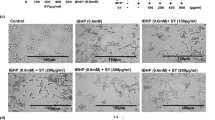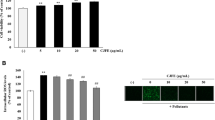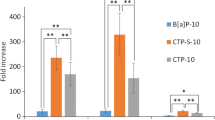Abstract
Skin cancer pathogenesis is partially associated to the oxidative stress conditions induced by environmentally carcinogens such as benzo[a]pyrene (BaP). The protective effects against BaP-induced oxidative stress of the flavonoid hesperetin as a complex with the 2-hydroxypropyl-β-cyclodextrin (HE/HP-β-CyD) have been evaluated using an ex vivo human skin model. Human healthy skin has been pre-treated with the functionalized complex HE/HP-β-CyD (0.5–50 μM) before BaP (5 μM) application simulating occupational and environmental exposure. Oxidative stress was evaluated in terms of 3-(4, 5-dimethylthiazol−2-yl)-2, 5-dipheyltetrazolium bromide reduction, protein peroxidation and reactive oxygen species (ROS) formation. Additionally, it has been investigated whether the potential protective effects of HE/HP-β-CyD may be correlated to the interaction with aryl hydrocarbon receptor (AhR) pathway. A significant protection by HE/HP-β-CyD against the BaP-induced increase in ROS and carbonyl compound production, as well as reduction in tissue viability, has been observed (p < 0.001). Results obtained showed that HE/HP-β-CyD was also able to reduce BaP-induced AhR and CYP1A1 protein expression (p < 0.001). Experimental evidences provided from this study suggest significant preventive properties of HE/HP-β-CyD in the toxicity caused by environmental carcinogens such as PAHs.




Similar content being viewed by others
Abbreviations
- BaP:
-
Benzo[a]pyrene
- HE/HP-β-CyD:
-
2-Hydroxypropyl-β-cyclodextrin
- AhR:
-
Aryl hydrocarbon receptor
- PAHs:
-
Polycyclic aromatic hydrocarbons
- ROS:
-
Reactive oxygen species
- HE:
-
Hesperetin
- DCFDA 2:
-
7-Dichlorofluorescein diacetate
- GAPDH:
-
Glyceraldehyde-3-phosphatase dehydrogenase
References
Afaq F. Natural agents: cellular and molecular mechanisms of photoprotection. Arch Biochem Biophys. 2011;508:144–51.
Baudouin C, Charveron M, Tarroux R, Gall Y. Environmental pollutants and skin cancer. Cell Biol Toxicol. 2002;18:341–8.
Bonina F, Lanza M, Montenegro L, Puglisi C, Tomaino A, Trombetta D, et al. Flavonoids as potential protective agents against photooxidative skin damage. Int J Pharm. 1996;145:87–94.
Bouzari N, Romagosa Y, Kirsner RS. Green tea prevents skin cancer by two mechanisms. J Invest Dermatol. 2009;129:1054.
Burke K, Wei H. Synergistic damage by UVA radiation and pollutants. Toxicol Ind Health. 2009;25:219–24.
Calabrese EJ, Baldwin LA. The hormetic dose-response model is more common than the threshold model in toxicology. Toxicol Sci. 2003;71:246–50.
Ciolino HP, Daschner PJ, Yeh GC. Dietary flavonols quercetin and kaempferol are ligands of the aryl hydrocarbon receptor that affect CYP1A1 transcription differentially. Biochem J. 1999;340:715–22.
Costa C, Catania S, De Pasquale R, Stancanelli R, Scribano GM, Melchini A. Exposure of human skin to benzo[a]pyrene: role of CYP1A1 and aryl hydrocarbon receptor in oxidative stress generation. Toxicology. 2010;271:83–6.
Dekker P, Parish WE, Green MR. Protection by food-derived antioxidants from UV-A1-induced photodamage, measured using living skin equivalents. Photochem Photobiol. 2005;81:837–42.
Doostdar H, Burke MD, Mayer RT. Bioflavonoids: selective substrates and inhibitors for cytochrome P450 CYP1A and CYP1B1. Toxicology. 2000;144:31–8.
Elbekai RH, Korashy HM, Wills K, Gharavi N, El-Kadi AO. Benzo[a]pyrene, 3-methylcholanthrene and beta-naphthoflavone induce oxidative stress in hepatoma hepa 1c1c7 cells by an AHR-dependent pathway. Free Radic Res. 2004;38:1191–2004.
International Agency for Research on Cancer (IARC). Polynuclear aromatic compounds, part 1, chemical, environmental and experimental data. In: Evaluation of carcinogenic risks to humans. Lyon: IARC Press; 1983. p. 211.
Janmohamed A, Dolphin CT, Phillips IR, Shephard EA. Quantification and cellular localization of expression in human skin of genes encoding flavin-containing monooxygenases and cytochromes P450. Biochem Pharmacol. 2001;62:777–86.
Kale A, Gawande S, Kotwal S. Cancer phytotherapeutics: role of flavonoids at the cellular level. Phytother Res. 2008;22:567–77.
Kao ES, Wang CJ, Lin WL, Chu CY, Tseng TH. Effects of polyphenols derived from fruit of Crataegus pinnatifida on cell transformation, dermal edema and skin tumor formation by phorbol ester application. Food Chem Toxicol. 2007;10:1795–804.
Kim JY, Jung KJ, Choi JS, Chung HY. Hesperetin: a potent antioxidant against peroxynitrite. Free Radic Res. 2004;38:761–9.
Krishnan R, Maru GB. Inhibitory effect(s) of polymeric black tea polyphenols on the formation of B(a)P-derived DNA adducts in mouse skin. J Environ Pathol Toxicol Oncol. 2005;24:79–90.
Lens MB, Dawes M. Global perspectives of contemporary epidemiological trends of cutaneous malignant melanoma. Br J Dermatol. 2004;150:179–85.
Levine RL, Garland D, Oliver CN, Amici A, Climent I, Lenz AG, et al. Determination of carbonyl content in oxidatively modified proteins. Methods Enzymol. 1990;186:464–78.
Linden KG, Carpenter PM, McLaren CE, Barr RJ, Hite P, Sun JD, et al. Chemoprevention of nonmelanoma skin cancer: experience with a polyphenol from green tea. Recent Results Cancer Res. 2003;163:165–71.
McClean MD, Rinehart RD, Ngo L, Eisen EA, Kelsey KT, Wiencke JK, et al. Urinary 1-hydroxypyrene and polycyclic aromatic hydrocarbon exposure among asphalt paving workers. Ann Occup Hyg. 2004;48:565–78.
McNaughton SA, Marks GC, Green AC. Role of dietary factors in the development of basal cell cancer and squamous cell cancer of the skin. Cancer Epidemiol Biomarkers Prev. 2005;14:1596–607.
Mehrabi MR, Steiner GE, Dellinger C, Kofler A, Schaufler K, Tamaddon F, et al. The arylhydrocarbon receptor (AhR), but not the AhR-nuclear translocator (ARNT), is increased in hearts of patients with cardiomyopathy. Virchows Arch. 2002;441:481–9.
Mishra PR, Al Shaal L, Müller RH, Keck CM. Production and characterization of Hesperetin nanosuspensions for dermal delivery. Int J Pharm. 2009;371:182–9.
Nakatsuru Y, Wakabayashi K, Fujii-Kuriyama Y, Ishikawa T, Kusama K, Ide F. Dibenzo[A, L]pyrene-induced genotoxic and carcinogenic responses are dramatically suppressed in aryl hydrocarbon receptor-deficient mice. Int J Cancer. 2004;112:79–83.
Pacheco-Palencia LA, Noratto G, Hingorani L, Talcott ST, Mertens-Talcott SU. Protective effects of standardized pomegranate (Punica granatum L.) polyphenolic extract in ultraviolet-irradiated human skin fibroblasts. J Agric Food Chem. 2008;56:8434–41.
Pollard SE, Whiteman M, Spencer JP. Modulation of peroxynitrite-induced fibroblast injury by hesperetin: a role for intracellular scavenging and modulation of ERK signalling. Biochem Biophys Res Commun. 2006;347:916–23.
Procházková J, Kozubík A, Machala M, Vondráček J. Differential effects of indirubin and 2,3,7,8-tetrachlorodibenzo-p-dioxin on the aryl hydrocarbon receptor (AhR) signalling in liver progenitor cells. Toxicology. 2011;279:146–54.
Reiners Jr C, Jones L, Hong N, Myrand SP. Differential induction of Cyp1a1, Cyp1b1, Ahd4, and Nmo1 in murine skin tumors and adjacent normal epidermis by ligands of the aryl hydrocarbon receptor. Mol Carcinogen. 1998;21:135–46.
Sander CS, Chang H, Hamm F, Elsner P, Thiele JJ. Role of oxidative stress and the antioxidant network in cutaneous carcinogenesis. Int J Dermatol. 2004;43:326–35.
Shima H, Koike E, Shinohara R, Kobayashi T. Oxidative ability and toxicity of n-hexane insoluble fraction of diesel exhaust particles. Toxicol Sci. 2006;91:218–26.
Stohs SJ. Oxidative stress induced by 2,3,7,8-tetrachlorodibenzo-p-dioxin (TCDD). Free Radic Biol Med. 1990;9:79–90.
Swanson HI. Cytochrome P450 expression in human keratinocytes: an aryl hydrocarbon receptor perspective. Chem Biol Interact. 2004;149:69–79.
Szaefer H, Krajka-Kuźniak V, Baer-Dubowska W. The effect of initiating doses of benzo[a]pyrene and 7,12-dimethylbenz[a]anthracene on the expression of PAH activating enzymes and its modulation by plant phenols. Toxicology. 2008;251:28–34.
Tommasini S, Calabrò ML, Stancanelli R, Donato P, Costa C, Catania S, et al. The inclusion complexes of hesperetin and its 7-rhamnoglucoside with (2-hydroxypropyl)-beta-cyclodextrin. J Pharm Biomed Anal. 2005;39:572–80.
Tsai YH, Lee KF, Huang YB, Huang CT, Wu PC. In vitro permeation and in vivo whitening effect of topical hesperetin microemulsion delivery system. Int J Pharm. 2010;388:257–62.
Vargas AJ, Burd R. Hormesis and synergy: pathways and mechanisms of quercetin in cancer prevention and management. Nutr Rev. 2010;68:418–28.
Author information
Authors and Affiliations
Corresponding author
Rights and permissions
About this article
Cite this article
Melchini, A., Catania, S., Stancanelli, R. et al. Interaction of a functionalized complex of the flavonoid hesperetin with the AhR pathway and CYP1A1 expression: involvement in its protective effects against benzo[a]pyrene-induced oxidative stress in human skin. Cell Biol Toxicol 27, 371–379 (2011). https://doi.org/10.1007/s10565-011-9194-6
Received:
Accepted:
Published:
Issue Date:
DOI: https://doi.org/10.1007/s10565-011-9194-6




